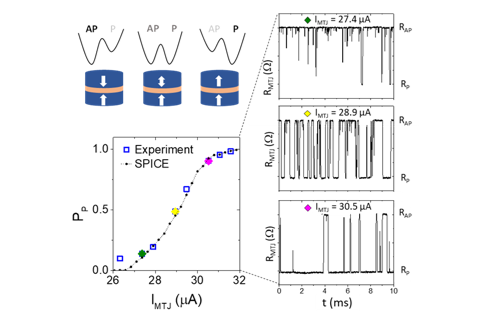We study recurrent networks of binary stochastic Magnetic Tunnel Junctions (sMTJ), aiming at efficiently solving computationally hard optimization problems. After validating a prototyping route, we investigate the impact of hybrid CMOS+MTJ building block variants on the quality of stochastic sampling, a key feature for optimum search in a complex landscape. We carry out a functional and power consumption analysis on asynchronous Ising networks for factorization task, supported by our SPICE model.
Scope of this work is to apply the Ising model (energy-based local search algorithm) to solve efficiently the Boolean satisfiability problem. Boolean clauses are represented by interconnected logic Gates, which are themselves mapped to networks of resistively-coupled stochastic magnetic tunnel junctions. MTJs can be biased by spin-transfer torque (STT) or spin-orbit torque (SOT).
Discrete optimization problems are ubiquitous in modern society, spanning a wide range of fields such as logistics, finance, telecommunications, and manufacturing. However, as the search space increases exponentially with problem size, looking for optimal solutions can become extremely time and energy consuming, especially on conventional computing architectures. Originally describing the dynamics of ensembles of coupled spins, the Ising model has inspired some of the best performing optimization algorithms. Notably, this model relies on local updates and leveraging randomness to provide good quality solutions in a reduced time.
In this context, our approach is to emulate an Ising model with building blocks based on stochastic tunnel magnetic tunnel junctions (MTJ) spontaneously interacting through a resistive coupling network. To produce these stochastic computing units, Spintec and CEA-Leti jointly integrated MTJs onto CMOS wafers, and adjusted the MTJ stack to convert thermal noise into random fluctuations. In an Ising network, these fluctuations need to be biased by a decoupled input signal. Our study underscores the advantage of the Spin-Orbit Torque (SOT) writing mechanism on three-terminal MTJs for enhanced tunability. We carried out circuit-level simulations to demonstrate the successful factorization of an 8-bit semi-prime number by a network of 48 coupled stochastic units, gradually decreasing the randomness through the coupling resistances, and performing a power consumption analysis.
This study lays the groundwork for further optimization of stochastic building blocks and coupling components within scalable networks for an energy-efficient demonstration of a fully-integrated prototype.
Team: Spintronics IC design, MRAM, AI
Collaboration: CEA-LETI/LDMC
Funding: French National Research Agency (ANR) through the RENATECH network, the Carnot SIGMA project, France 2030 government grant EMCOM (ANR-22-PEEL-0009), and the joint NSF-ANR grant StochNet (ANR-21-CE94-0002-01).
Further reading: Designing networks of resistively-coupled stochastic Magnetic Tunnel Junctions for energy-based optimum search, K. Garello et al., Open access: hal-04359859
Contact: Kevin Garello

